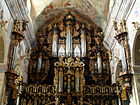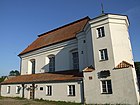Baroque in Poland
| Part of a series on the |
| Culture of Poland |
|---|
 |
| Traditions |
|
Mythology |
|
Cuisine |
| Festivals |
| Religion |
The Polish Baroque lasted from the early 17th to the mid-18th century. As with Baroque style elsewhere in Europe, Poland's Baroque emphasized the richness and triumphant power of contemporary art forms. In contrast to the previous, Renaissance style which sought to depict the beauty and harmony of nature, Baroque artists strove to create their own vision of the world. The result was manifold, regarded by some critics as grand and dramatic, but sometimes also chaotic and disharmonious and tinged with affectation and religious exaltation, thus reflecting the turbulent times of the 17th-century Europe.
Baroque and Sarmatism

The Polish Baroque was influenced by Sarmatism, the culture of the Polish nobility (szlachta).[1] Sarmatism became highly influenced by the Baroque style and produced a unique mix of Oriental (Ottoman) and Western (French, Italian) styles.[1] Those Oriental influences stemmed from a large border shared by Poland with the Ottoman Empire, and the frequent skirmishes between the two countries.[1]
A Sarmatist thought had praised the idyllic countryside-existence, and the liberal
On a more material realm,
Counter-reformation

The

The monumental castle

During the late 17th century, the most famous architect in the Commonwealth was the Dutch-born
.A notable style of Baroque architecture emerged in the 18th century with the work of
Architecture
The first Baroque structure in the
In the subsequent years of the early 17th century, Baroque architecture spread over the Commonwealth. Important Baroque churches built during this early phase of the style included the

The monumental castle
During the late 17th century, the most famous architect in the Commonwealth was the Dutch-born
.A notable style of Baroque architecture emerged in the 18th century with the work of
Early Polish baroque buildings were often designed by foreign (most often, Italian) architects. The first
Secular Baroque architecture also grew. The royal
Prominent examples
- Churches
-
Visitationist Church in Warsaw
-
Basilica of the Blessed Virgin Mary, Święta Lipka
-
King's Chapel by Tylman van Gameren, Gdańsk
-
Monastery of Philip Neri's Oratory, Głogówko
-
Visitation of Our Lady Basilica, Wambierzyce
- Palaces
- Castles
- Tenements
- Church interiors
- Judaica
References
- ^
- ^ a b "Palaces and Castles in a Lion Country". www.lvivtoday.com.ua. June 2, 2008. Archived from the original on 2020-04-25. Retrieved 2009-05-19.
- ^ ISBN 0-19-210006-8.
- ^ a b Danuta Szmit-Zawierucha (July 2003). "Tylman van Gameren of Warsaw". Articles. Warsaw Voice.pl. Retrieved November 30, 2012. (in English)
- ^ ISBN 9955-463-02-3.
- ^ a b Christiane Bauermeister: Litauen, 2007, Seite 70 (Digitalisat)
- ^ Aliaksiej Sierka. "The Farny Roman-Catholic Church". www.belarusguide.com. Archived from the original on 8 July 2010. Retrieved 2010-08-06.
- ^ ISBN 83-232-0408-X.
- ^ ISBN 1-85828-168-7.
- ^ Mark Salter; Gordon McLachlan; Chris Scott (2000). The spirit of austerity and the materials of opulence: Architectural sources of St. Casimir's Chapel in Vilnius. Journal of Baltic Studies, Volume 31, Issue 1. pp. 5–43.
- ISBN 3-7845-7611-7.
- ^ Doreen E. Greig (1987). The reluctant colonists: Netherlanders abroad in the 17th and 18th centuries. Van Gorcum. p. 27.
- ISBN 3-88618-088-3.
- ^ (in English) "Castle's history". www.zamek-lancut.pl. Archived from the original on 2021-01-19. Retrieved 2010-08-01.




































